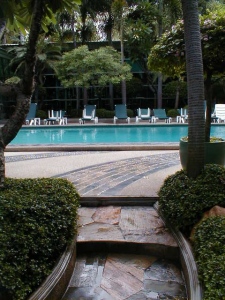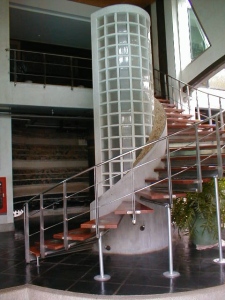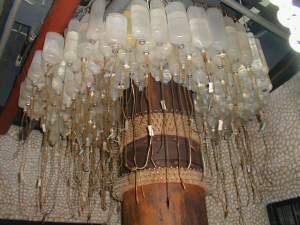 This excerpt, from Chapter 14, “Men of the Feast: Babylon,” describes the details of an architecture of masculinity that challenges the triple supremacist ideology of romantic, heterosexual monogamy.
This excerpt, from Chapter 14, “Men of the Feast: Babylon,” describes the details of an architecture of masculinity that challenges the triple supremacist ideology of romantic, heterosexual monogamy.
[Khun Toc] had returned to Thailand to help manage the family banking business. By then he was old enough to begin to be referred to consistently as the more respectful “Khun Toc,” the word “khun” conveying a meaning similar to the English “mister.” By the mid-1980s a buy-out of the banking business had left only the family’s real estate to be overseen. Among the landholdings was a sand-colored condominium building at the start of a small road called Soi Nantha. It was about a kilometer south of the statue of Vajiravudh in neighboring Lumphini Park and of the Patpong district where Darrell Berrigan had taken his last meal. Khun Toc would begin his construction of what he hoped would be a new first-class paradise for men in Southeast Asia by re-modeling one condo in the building, then as others became available another, and another, and another until he had poked holes in a zigzagging maze that rose to the top of the four-story building and to its crown: a rooftop hanging garden with views that extended across the Chao Phraya River delta.
It was the rooftop garden that would inspire the name of his new paradise –Babylon, for its hanging gardens – although Khun Toc also enjoyed the meanings of the actual word. For Jews, “Babel” had meant a gate of God; for Christians it had evoked promiscuity.
For Khun Toc, the two seemed to go together: spirit and sex.
On May 23, 1987, he opened. [He would later relocate the sauna to another family property along the same road.]

By choosing to build a sauna, Khun Toc had selected what was one of the most controversial types of all gay male geographies. Dennis Altman, an Australian scholar, had described why in a book just five years earlier. Such a space for men to gather, Altman had written, was one of the aspects of gay male life “that most infuriates” because it provided a deliberately imagined and built environment where not only male-male sex could occur, but where a different type of masculinity could be enacted. “The willingness,” Altman had written, “to have sex immediately, promiscuously, with people about whom one knows nothing and from whom one demands only physical contact, can be seen as a sort of Whitmanesque democracy, a desire to know and trust other men in a type of brotherhood far removed from the male bonding of rank, hierarchy and competition that characterizes much of the outside world.”
It was an architecture for savoring the male body and male companionship without any presumption of romance, or marriage, or heterosexuality….

Khun Toc’s selections of details for this new imagined environment for the male body had obviously been influenced by his studies in the United States and his travels in Europe, but his idea for Babylon did not appear to have emerged from his time in either country. He had been in both during the heyday of 1970s gay liberation, but he had never been to a gay sauna.
Instead, friends say, the concept emerged from the discipline he had set once he returned to Bangkok. To adjust back to his homeland of Thailand and to meet new friends, he had regularly hosted garden parties at his family’s home near Bangkok’s Thanon Sukhumvit. It would be the ritual of the Thai garden party — with its appetizers, its music, its notions of playful sanuk, its courteous bows from servants, — that he chose as his organizing metaphor for Babylon. Within that ritual, he could fold together the necessary elements of sounds, lights, and rhythmic movements needed to forge a different kind of environment that could act both as a space of freedom for the men who came as well as a place that could feel like a home.
Other gay saunas might fulfill the function of allowing men to have sex with one another. In Babylon, Khun Toc planned an architecture and interior design that seemed to focus more on the form of communication between men that was supposed to occur. Asked once what concept had motivated his construction of the sauna, Khun Toc answered quickly:
“What’s important in a sauna,” he said, “is what happens after the sex….”

Limit the definition of male sex to its biological function of ejaculation and reproduction and it is easy to fall into an architecture that looks like a Bauhaus building where function reigns supreme. The sauna becomes a utilitarian rain gutter for draining excess fluid. Such an approach usually produces an emphasis on standard rectangular private rooms occupying most of the space available so as to most efficiently squeeze profit. It takes only the barest of cheap snack food, sparse furnishings and steam mingled in rent-cheap buildings that reinforce the idea that male-male sex is lived on the margins and that this particular gender performance of masculinity is to be deeply hidden as far away from the public realm of manhood as possible.
But if an understanding of male-male sex is built upon form, upon the pleasure that derives from it as one of many types of male communication, then that disagreement with the culture can produce a radically different architecture. Khun Toc would eventually adopt a slogan for his newly built geography: “Babylon, where arts, sex and love converge.”
Originally, the apartment mid-rise Toc’s family owned had been little more than a concrete functionalist building of the type that had spread across Bangkok in the 1960s and 1970s. One guidebook called such a building “a giant egg carton turned on its side.” When Toc started remodeling, he drove the building toward a style that had prevailed in Bangkok in the 1920s when Vajiravudh ruled — a type of Thai Deco that blended masculine elements of restrained industrialism with flourishes and illusions coming from the European Deco.
The upper four floors of the seven-story building he turned into the “Barracks;” the lower floors formed the Babylon sauna.

Inside both, he stripped open the ceilings to expose their functions, showing the pipes and conduits that carried water and electricity. The effect was like entering a no-frills warehouse. But in a Deco flourish, he then had the pipes in the ceiling painted in varied blacks, rusts and tans and made many of them simply decorative. What at first glance could look like a large black water pipe on its way through a room instead collided with an impenetrable concrete beam. Functioning pipes and conduits became indistinguishable from the purely decorative ones, not pipes or conduits at all but an updated version of the floral fascias that lined the ridges of his old family home outside.
 Khun Toc played with textures. Two large columns past Vajiravudh’s picture appeared to be made of smooth rusted iron. He studded them with rings of nails, creating a pattern of alternating smooth and hard textures that would be echoed throughout the sauna’s restaurants, patios, and stairways. For smoothness, he composed with metal, glass, or cool black Thai slate. For roughness he chose white marble-sized river pebbles and coarse sandstone nuggets. Sometimes, he installed metal grates amid interior walkways, ostensibly looking as if they were for drainage. Instead, since most of the men coming to his architectural island walked about bare foot, the grates produced changes in tactile sensation. Along one staircase with smoothly burnished metal railings, rough holes popped opened for no particular function, but for the form of stimulating other sudden changes in the sense of touch. Whether on the floors being trod by thousands of bare feet or on the walls that the men leaned against – or sometimes felt their way along in dark minotaur-like mazes, Khun Toc insisted that the flat surfaces turn surprisingly tactile and musical, just as Walter Spies had insisted he wanted in his paintings.
Khun Toc played with textures. Two large columns past Vajiravudh’s picture appeared to be made of smooth rusted iron. He studded them with rings of nails, creating a pattern of alternating smooth and hard textures that would be echoed throughout the sauna’s restaurants, patios, and stairways. For smoothness, he composed with metal, glass, or cool black Thai slate. For roughness he chose white marble-sized river pebbles and coarse sandstone nuggets. Sometimes, he installed metal grates amid interior walkways, ostensibly looking as if they were for drainage. Instead, since most of the men coming to his architectural island walked about bare foot, the grates produced changes in tactile sensation. Along one staircase with smoothly burnished metal railings, rough holes popped opened for no particular function, but for the form of stimulating other sudden changes in the sense of touch. Whether on the floors being trod by thousands of bare feet or on the walls that the men leaned against – or sometimes felt their way along in dark minotaur-like mazes, Khun Toc insisted that the flat surfaces turn surprisingly tactile and musical, just as Walter Spies had insisted he wanted in his paintings.
When it came to lighting, Khun Toc turned to principles of shadowing. Bright in one place, shafted in another, totally absent in still another. Glass expanses or tiny portholes appeared almost everywhere so that men could see each other moving through different sections of the buildings or, in certain located, could peer out of the sauna entirely into Khun Toc’s private garden next door.
Babylon’s phet would be one of constantly fluidity.
Copyright (c) 2012, Hong Kong University Press
Buy Imagining Gay Paradise from Amazon.com, Barnes & Noble, Columbia University Press, Hong Kong University Press, Silkworm Books, Kinokuniya Thailand, Kinokuniya Singapore, University of British Columbia Press, Eurospan
Add Imagining Gay Paradise to your Goodreads:
